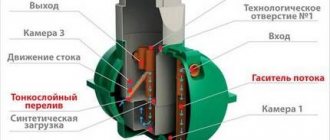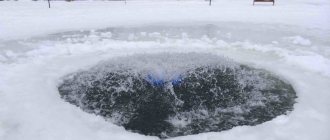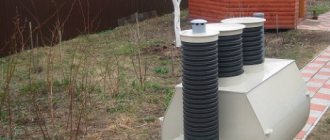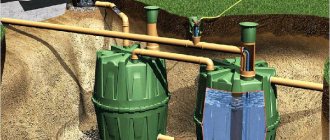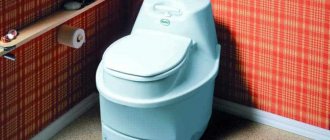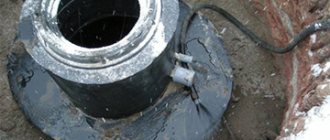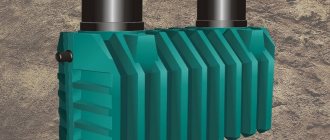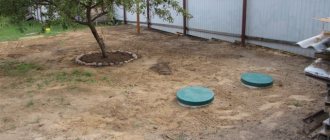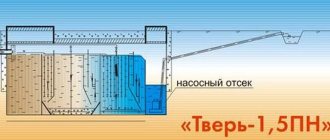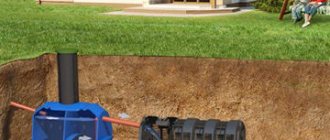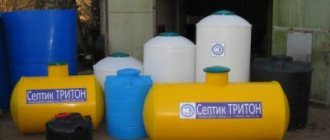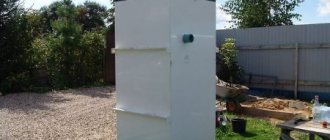A modern country house is as comfortable as a city apartment. It is equipped with a toilet, shower, washing machine and dishwasher. At the same time, centralized sewerage is most often absent. Its functions can be performed by a septic tank for a summer residence Tank, in which wastewater is accumulated and partially processed.
The treatment plant has gained popularity due to its simplicity of design, reliability and affordable cost. Are you unsure about your purchase? We invite you to familiarize yourself with the structure and operating principle of a septic tank, its pros and cons, as well as the rules for installation and maintenance.
The information presented will help you decide on the choice of modification of the Tank purifier and understand the feasibility of its installation. The material will also be useful to those who already use a storage septic tank at their dacha.
Construction of a septic tank “Tank”
A septic tank is a treatment facility in which accumulation, sedimentation and partial biological purification of wastewater occurs. It consists of one to three sections connected in series, the last of which is divided into two chambers.
The second chamber contains a biofilter designed for anaerobic processing of wastewater, and a floating load that performs filtration at the outlet of the tank.
Image gallery
Photo from
Cast structures for autonomous sewage systems
Model range of septic tanks for arranging a summer house
A set of devices for sewerage construction
Advantages of a ribbed plastic case
As a result of multi-stage purification in the process of overflow, treatment with bacteria and filtration, the purification degree reaches 78-80%. After leaving the treatment plant, the wastewater enters an infiltrator installed on the ground. Here, additional purification takes place up to 95 - 100% and the purified mass is discharged into the underlying layers of soil, filtration fields or sewers.
The installation of septic tank sections, the laying of inlet and outlet communications should be carried out in strict accordance with the manufacturer’s recommendations and in relation to the specific geological and hydrogeological situation on the site (+)
At dachas, devices presented in one housing are most often used.
The structure consists of the following elements:
- Housing , the volume of which is divided into two or three sections by partitions with overflows.
- Biofilter with polymer floating loading.
- Branch pipes - inlet and outlet.
- One or two necks with tight-fitting lids.
The number of sections in a septic tank depends on its total volume. Two chambers have small-volume septic tanks capable of processing up to 600 liters of wastewater per day ( Tank-1 ). The rest are divided into three parts.
The sewer treatment system with the Tank logo can include one or more sections depending on the processing needs
The productivity (daily volume of water disposal) of single-body septic tanks, depending on the modification, is enough to serve from one to six residents, which corresponds to water disposal within 1200 l/day.
If it is necessary to process a larger amount of wastewater, then separate modules serve as working chambers, each of which in this case performs its own function. This is how the Tank-4 - it consists of three tanks connected by overflows.
In addition, by successively adding additional containers, you can increase the performance of the cleaning system with any version of the Tank septic tank to the required level.
All components are made of polymer materials and are not subject to corrosion, water erosion or soil erosion (+)
Features of the housing design
The body of the device is a monolithic cast container made of ribbed polyethylene, without any seams or joints. Thanks to its rectangular shape, the septic tank is compact and stable, so it is quite easy to install even for a non-professional.
In the upper part of the hull there are one (Tank-1) or two service hatches. The necks are attached to the sealant according to the male-female principle.
Ribbed walls, remaining elastic and resilient at any temperature, increase the rigidity and strength of the structure. If installed correctly, they can withstand soil pressure even during frost heaving.
The ribbed surface increases the adhesion of the tank to the surrounding dense sand-cement cushion, due to which it is firmly held in the ground and does not float up during spring floods. Therefore, the septic tank Tank does not require additional anchoring during installation.
Monolithic cast polypropylene body, reinforced with stiffening ribs, calmly withstands the destructive influences of the environment - uneven soil pressure, periodic washing out with water and temperature changes
The material from which the tank is made is a durable polymer compound. It is completely safe from an environmental point of view, biologically pure material.
It does not decompose under the influence of microorganisms, does not react with chemicals, and is not subject to soil erosion and corrosion. The service life of a polypropylene tank is at least 50 years.
Biofilter design and functions
The biofilter in a septic tank is always installed in the last chamber. It is a container in which optimal conditions are created for the growth and reproduction of bacterial colonies. To ensure the physical possibility of microorganisms settling, the filter is filled with floating bioload.
The main labor force of the biofilter is anaerobic bacteria, colonies of which settle on the walls and bottom of the tanks. Filtration beds are products whose shape allows, with minimal dimensions, to create a large area for mechanical cleaning.
The polymer elements of the floating load are lighter than water, so they float up and are located at the outlet pipe of the section with the biofilter. The manufacturing material is chemically stable and absolutely safe for any aquatic organisms.
Bioload elements have different shapes - they can be simply polymer granules or large chips (crushed pieces). It is important that they create free space capable of “attaching” the maximum amount of contaminants.
The free surface area is the main indicator of the performance of the biological load and determines the capacity of the entire treatment system.
In addition to processing by hydrobionts, centrifugal separation also occurs in the biofilter. The filter container itself is made in a form that allows it to work on the principle of a hydrocyclone.
The inlet holes are located in such a way that water enters at a certain angle (tangentially) and unwinds. Due to vortex microflows, all remaining heavy suspensions are eliminated.
Pros and cons of septic tank Tank
Among the many positive aspects of the Tank septic tank and all its modifications, the following are worth mentioning:
- Affordability (in terms of total costs, the station is even cheaper than its analogue made from concrete rings);
- Energy independence (except for BioTank);
- Possibility of installation on soils of any type and water content;
- Small size and lightweight design, facilitating manual installation;
- High strength plastic housing;
- Extreme ease of operation and maintenance;
- Low probability of clogging of internal chambers;
- Service life up to half a century.
The septic tanks in question can be installed on the site at any time of the year. Problems will arise only with digging frozen ground. You can choose a place for the “Tank” right next to the house at a distance of 2–3 meters from it. It doesn’t matter whether a strip or column foundation is used to build housing, moisture from the sealed housing will not seep into the ground and affect the concrete.
But the infiltrator should be removed from the base of the building, on the contrary, further away. The humidity around it is always high. If you place it next to a residential building, then even precipitation-resistant facade plaster from the walls of the house will sooner or later begin to fall off.
The negative aspects of this septic tank are as follows:
- Large volumes of work when digging a pit for the station and installing an infiltrator;
- The need to organize additional treatment using a filtration field or well.
The effluent in the anaerobic VOC "Tank" is treated only up to 80%. Without the use of an infiltrator, such water cannot be discharged into a reservoir or used for watering beds. In this regard, this septic tank is somewhat inferior to competitors of the same factory design.
Operating principle of the installation
Wastewater treatment in a septic tank Tank occurs only mechanically and biologically, without the use of any chemicals. If the structure includes three sections, then the process is accordingly divided into three stages.
Each stage takes place in its own working area:
- The first section is the reception section. All household waste flows into it through the sewer from the house and settles. Here fermentation and mechanical separation take place - layer-by-layer separation of liquid fractions of different weights. Heavy particles sink to the bottom, light particles (fat, feces, etc.) rise to the surface, and clarified water remains in the middle.
- Second section . Liquid from the middle layer of the primary container enters it through the overflow. Here it continues to ferment under the influence of microorganisms and settle - the movement occurs very slowly, without external disturbances. This promotes the settling of small inclusions that did not have time to precipitate in the previous settling tank.
- The third section is a biofilter. In its lower part, centrifugal separation and purification from residual heavy impurities is carried out. Liquid that is contaminated only of a biological nature approaches the upper part of the filter. When passing through a bioload, where bacterial colonies are concentrated, organic matter is removed.
The solid sediment that has settled to the bottom, formed as a result of filtration, separation and the work of bacteria, must be periodically removed through the hose of the sewer machine.
To prevent the solid components of processed waste that have settled to the bottom from being pressed and compacted, at least once a year it is necessary to pump them out through a hose connected to the vacuum cleaner machine.
Colonies of bacteria that live and multiply in the space of the biological load use organic matter dissolved in water as food. Therefore, recycling occurs naturally. The process produces harmless carbon dioxide, some volatile hydrocarbons and water.
To remove gases, ventilation is installed, which is a mandatory element of the cleaning system. Otherwise, volatile elements released during fermentation and biodegradation will accumulate in the container and be released through the sewer line into the home. An unpleasant odor will fill the building.
Septic tanks Tank are sealed containers in which the biological treatment of wastewater is carried out by anaerobic bacteria, without access to oxygen. These microorganisms are less effective than aerobic microorganisms (used in energy-dependent systems).
Therefore, the degree of purification of water from organic matter when leaving the septic tank reaches 75-80%. Draining such liquid into the ground is prohibited by sanitary standards.
The efficiency of a septic tank depends on the free area of the bioload and the size of the population of microorganisms. The speed of fluid movement in the system also affects the degree of purification - the higher it is, the less pure water comes out of the tank (+)
To further purify wastewater after the Tank septic tank, a ground filtration device must be used. These are structures in which water from a septic tank passes through a layer of crushed stone or gravel. All remaining contaminants settle in the filter mound.
A treatment facility based on a septic tank Tank includes one or more infiltrators that perform post-treatment of wastewater and discharge the treated mass into the ground, filtration fields, and sewers.
Such devices are:
- infiltrators - industrially manufactured tanks without a bottom (resemble an inverted bathtub);
- filtration fields – drainage pipe system;
- filter well - an absorption tank without a bottom with a drainage layer.
The type of structure and installation scheme of the sewer system are selected depending on the type of soil on the site and the groundwater level. It is best to consult a specialist on this issue.
When installed correctly, the septic tank Tank works effectively both in dry weather and during spring floods and heavy rains. It is not afraid of frost heaving and seasonal soil shifts.
The simplest and fastest setup. Suitable for soils characterized by normal water absorption - sandy, gravel, pebble
Reviews of septic tanks Tank
Reviews for the septic tank in question are full of laudatory epithets. Those who bought the “Tank” write that it is cheap, can be installed in literally 3-4 hours, has a durable body and, due to its modular design, allows you to quickly increase the station’s capacity at any time.
At the same time, the main complaint that owners have about it is the need for frequent cleaning. But this happens more due to incorrectly selected volume. Sludge accumulates in the septic tank and must be removed from time to time. To do this less often, you just need to choose a VOC with a larger capacity.
Positive reviews
- I installed a Tank-1 septic tank sewage system on a country house. In my opinion, this is the most optimal solution for me. Ease of operation, reliable design, and a good company that has been involved in wastewater treatment plants for 8 years. © Tractor driver, forum.rmnt.ru
- We encountered the same problem. A lot of information was shoveled through. It seems that we settled on the “TANK” septic tank. The spouse considers him the most accessible and correct. © Sofia166, forum.rmnt.ru
Negative reviews
- Septic tanks such as TANK, TVER, etc. disappeared immediately, because these are septic tanks that do not purify water as efficiently, without an aeration system, but I wanted maximum purification, and these are only biological treatment stations such as TOPAERO, TOPAS and POPLER, which I did not know at the time of purchasing TOPAS. © panamera, forum.rmnt.ru
- I don’t like experiments, it can be too expensive, I only choose proven products when they work well. I also know the Tank, it’s popular, my neighbor installed it, he told me something about it, the plastic is fragile, it bends... © Vladimir 123, forum.rmnt.ru
- There are enough problems with him. Google it and you'll find everything. Well, and the price... why do all this when a normal three-cubic plastic barrel costs around thirty? Attaching pipes and a neck to it is not so difficult, but you don’t have to overpay and immediately redo it. © Serega1998, forum.vashdom.ru
- Is it true that a septic tank cannot cope with the drainage of the dishwasher and washing machine? I was about to buy it, and then they told me such negative things. So there are living organisms there. They will use yours with pleasure, but washing powder - sorry. You will poison them with detergents. © qwerqus, forum.vashdom.ru
- Well, the work is finished, I spent the whole summer on weekends. But in the end I thought, the next season will begin, and I will begin to enjoy the fruits of my labor. Aaaand... Arriving at the dacha in the spring, the first thing I did was run to see what was wrong with the septic tank, what was my surprise when I saw the lids slightly floating above the necks. The septic tank was full of clean water. At first I thought that it was flooded with melted snow from the top through the covers, since they were a little below ground level, I remembered the kind words of the Triton plastic managers, who deceived me with the input, which is why I had to shackle it so deeply, and began to pump it out water from the last well. After exposing the outlet pipe, I saw that water was pouring out of the septic tank in almost the same volume as it was being pumped out: mad: half an hour after turning off the pump, the septic tank was full. Having put on my fishing overalls, I climbed inside to inspect the connections.
This is not the biggest leak yet. From the connection of the first and second there are two such jets and with high pressure. ALL connections where black plastic is used (nipples from tanks) are leaking, even the last day off. Only the ill-fated inlet into the septic tank does not leak because it is made of a purchased plastic sewer corner and is embedded through a rubber coupling. Moreover, the connections bought in the store have retained their original roundness, and it flows precisely because the black nipples of the tanks seem to have been flattened and narrowed.
Morality, a lost summer, a lot of hassle and money, and a non-working septic tank that now needs to be dug up again and have sex with it. © Calisto, forumhouse.ru
- Well, I won’t say anything about bourgeois septic tanks, but I bought a TANK along with infiltrators last year. The quality is of course disgusting, the infiltrators ended up with a “bottom” due to sagging plastic underneath, and it took me a long time to cut off these swells with a knife. The inlet and outlet pipes in the septic tank were gray, that is, for internal work, I changed them to orange (someone in Triton “saved”). The circuit with a check valve only works on paper, my valve is always half-open in the well, thank God I didn’t buy the valve in Triton, but somewhere else, it has a lever to close it.
In Triton, one very “smart” manager, when purchasing, advised, if the groundwater level is high, to install a filtration well on rings without a bottom...
In general, the TANK has one plus so far - the price; the bourgeois ones are still VERY expensive. © jarosl, forumhouse.ru
- This is a manufacturing defect, after buying Tank-2, my water also began to leak, I contacted the “RESPECTED” office of the manufacturer of these miracle septic tanks, for a week I could not get an answer, in the end I called their “ENGINEER” and said poop more and the hole in the septic tank will silt up! Demand a replacement. © ilya811, forumhouse.ru
- I also encountered the same problem. All winter everything was fine, but today I went to see what was there and how it was - I discovered that the water from the septic tank had gone to the level of the overflow pipe from the containers. It is not yet clear where exactly the water goes. There is a suspicion of a vertical crack in the rib in the second tank. Located at approximately the same level. The height is 20-30 centimeters. The width is not large - as if a line was drawn with a simple pencil (maybe it’s not a crack at all, but a problem in another place). There are no options to call someone, dig them up, etc. - all this is not realistic. You can only pump out the septic tank and get in to specifically examine everything, and, if possible, brew it. By the way, I don’t know what you see as the problem with sealing - doesn’t the septic tank material melt? Take an industrial hair dryer and treat the crack... © Iserlohner, forumhouse.ru
How to increase system efficiency?
Microorganisms are distributed throughout the entire volume of the septic tank and are concentrated in the bioload. They enter the system along with wastewater, and, if there is a sufficient amount of organic matter, they successfully grow, multiply and eat organic components.
Thanks to bacteria, constant fermentation occurs in the septic tank. Due to this, organic matter, mineral suspensions and fat fractions are separated - the liquid is stratified.
The efficiency of wastewater treatment depends on the size of the microorganism population. The market offers a large selection of ready-made preparations containing colonies of bacteria - bioactivators. A popular drug is “Doctor Robik”.
By periodically adding them to the system, home owners improve the quality of cleaning. This is also an effective prevention against problems that arise when the bacterial population decreases - unpleasant odor, the formation of thick deposits on the walls, hardening of sludge.
The activity of anaerobes contributes to the liquefaction of bottom silt and dense crust on the surface, due to which the sewer service can be called much less frequently - once every three years.
The choice of drugs containing bacteria on the market is huge. When choosing, it is necessary to take into account the living conditions of microorganisms. Aerobes that require constant access to oxygen are not suitable for Tank septic tanks - their use can cause an imbalance in the operation of the system
When is the use of a bioactivator necessary?
For the normal functioning of bacteria, it is necessary that organic matter and a sufficient amount of liquid enter the system. Accordingly, for a constantly functioning septic tank, the use of industrial biological preparations is not necessary.
However, violations in operation lead to the death of colonies, as evidenced by the appearance of an unpleasant odor. In this case, the bioactivator should be added first. Most often, such a measure is sufficient to restore normal operation of the cleaning system.
In the following cases, you should not wait for the smell to appear, since in any case they help reduce the population of microorganisms.
It is better to immediately add a ready-made biological product, which is administered:
- After a long period of inactivity - for example, at the beginning of the summer season. If conservation was carried out properly, the bacteria in the septic tank do not die. However, their number is significantly reduced. The bioactivator helps to establish the functioning of the system in a much shorter time than would occur under natural conditions.
- and disinfectants into the sewer
- After the liquid freezes in the septic tank . This can happen if the tank is installed without an insulating layer.
Sewage odors also occur when a thick layer of fatty deposits has accumulated on the drain pipes and walls. Artificially added colonies of bacteria break down and liquefy sediments, after which they freely flow into the sump.
How to apply a bioactivator?
A couple of buckets (about 20 liters) of water are poured into the sewer. In order for the biomaterial to get into the septic tank, it is poured or poured into the toilet. After this, the water is drained two or three times.
Before introducing a bacterial preparation into the sewer, you should read the manufacturer's instructions
Before use, liquid preparations are simply shaken, but products in tablets or granules should be applied in accordance with the attached instructions. Some manufacturers recommend dissolving the biomaterial in water, others recommend adding it dry.
After adding the bacterial preparation, monitor the water level in the septic tank for two to three days, adding it as needed.
Why is additional filtration needed?
Anaerobes are not able to completely process organic compounds. They decompose complex compounds into simpler ones, which are contained in the liquid leaving the septic tank.
By pouring such water into the ground, you can become the culprit of contamination of it and groundwater. To completely break down simple organic matter, plums are exposed to aerobic bacteria.
When installing natural additional filtration, water from the septic tank passes through a layer of crushed stone or gravel, which is well saturated with oxygen. Aerobic microorganisms settle in such a filtration layer, the colonies of which grow and multiply when nutrient organic matter enters.
In this way, the last stage of complete wastewater treatment in the sewer system is carried out based on the Tank septic tank.
Features of operation
A compressor is used to pump air into the working chambers of the septic tank. Its installation must be carried out above the level of the liquid in the container.
When there is a power outage, which is by no means uncommon for dacha cooperatives, Tank bio septic tanks switch to autonomous mode, in which they can function with the same productivity for 24 hours. If the power supply is not restored within 24 hours, the quality of wastewater treatment will deteriorate significantly. If such problems exist, a post-treatment system should be provided.
According to the operating instructions, once a year you should clean the bioseptic tank receiver from the mineral sludge accumulated at the bottom. Otherwise, sediment compaction cannot be avoided, a reduction in the working volume of the receiver and, as a consequence, a decrease in the quality of wastewater treatment.
Before prolonged downtime, for example, before winter, the Biotank 3 septic tank, like other models in the line, should be mothballed:
- pump out sediment from the first and second compartments using sewage disposal equipment;
- rinse the cameras with water;
- Fill 2/3 of the bioseptic volume with water.
It is strictly prohibited to pump out the contents of the nitrifying compartment!
Which area is not suitable for such a septic tank?
The septic tank itself is absolutely not demanding on the soil. The case is durable and sealed, the material is not subject to any impact. The design ensures reliable operation, even if the housing is constantly in the water.
The presence of a sand-cement cushion around the container protects against uneven squeezing out of soil layers during frost heaving.
But there are other mandatory elements in the cleaning system. Since the additional filtration device requires good absorption of water into the ground, a high groundwater level can become an obstacle to the installation of such a septic tank. According to building regulations, there must be at least a meter between the filter bottom and the roof of the water-saturated layer.
Options for septic tanks that are suitable for areas with high groundwater are described here.
The second good reason is poorly absorbent clay soils, which do not allow treated wastewater to pass into or below them. In such situations, the filtration layer is in the water and does not fulfill its task: it does not free the system from the purified liquid component.
However, it is possible to use a non-volatile system in such areas. You just need to choose the right installation scheme.
For the installation of sewerage systems where groundwater is close to each other, infiltrators are used for additional purification, which are installed above the critical level. A storage well with a drainage pump is installed between the septic tank and the infiltrator.
A check valve is installed on the pipe entering the well. It prevents the reverse flow of water if the water level in the well rises above it (+)
If the site has clayey soil, then filtration fields are used for additional wastewater treatment. A drainage system is installed under the main filter layer; water accumulates in a well with a pump and is discharged to the surface into a drainage ditch.
Water discharged onto the terrain can be used for irrigation, technical and household needs
Installation
With the installation of the Biotank-4 PR septic tank, as with larger models, usually no difficulties arise. The stages of installing “Biotanks” are discussed in detail in this article.
Photo: installation process of Biotank septic tank
Installation work is carried out in several stages:
- digging a pit;
- leveling the bottom, filling a sand cushion 15 cm thick;
- installation and leveling of a septic tank;
- filling the gaps between the walls of the pit and the body of the septic tank with a mixture of sand and cement in a ratio of 5 to 1;
- laying insulation on top of the sprinkling;
- system connection;
- trial run.
Important! Installation of the Biotank-3 septic tank and other vertical models is possible only in areas with deep groundwater.
Photo: Biotank septic tank mounted in a pit
Installation and launch of a new installation
Before starting, the septic tank should be approximately 60-70% filled with water. Filling is carried out at the installation stage. Then, over the course of about two weeks, the clean water is gradually replaced by wastewater. After a sufficient amount of organic substances has accumulated in the tank, bioactivators are introduced into the sewer.
You shouldn’t wait for the drains to naturally fill with microflora. This takes up to several months, and during this time the quality of water purification will be low, an unpleasant odor and various kinds of problems may appear. For example, the accumulation of deposits in pipes and on the walls of the tank, which should not be allowed.
Therefore, it is necessary to establish the operation of the cleaning system as quickly as possible, which is where ready-made strains of bacteria help. Before purchasing, you should make sure that the bioactivator is intended for anaerobic septic tanks. Loading aerobes will result in a long startup time.
If you are interested in the features of installing a “Tank” septic tank, we have a separate article - we recommend that you read it.
Job
The principle of operation of the “Tank” septic tank is the sequential separation of mechanical impurities from the wastewater passing through the chambers.
This is done as follows:
- The receiving chamber is connected to the house sewer by an inlet receiving pipe. It separates the largest particles: sand, fat and food residues. The upper overflow discharges the wastewater further.
- The second chamber contains anaerobic bacteria that eat sewage, precipitating minerals to the bottom. This releases biogas, which escapes through the ventilation pipe. Purified water flows into the next chamber.
- The last section is equipped with a biological filter. Passing through it, the water is purified up to 70%, and when leaving the septic tank it no longer has any odor.
The septic tank does not achieve such high purity to use water for irrigation. It is fed further for soil purification. If water is discharged directly into the ground, it threatens the ecology of the site. Therefore, the “Tank” septic tank is equipped with an infiltrator, which is the most important part of the filtration field, which is made by hand. Going through natural filtration in the soil, the water is naturally purified up to 98% and will no longer pollute the entire territory.
Septic tank conservation rules
If the cleaning system works year-round, then there will be no problems, even if the owners leave the house for a couple of weeks. But if you plan to stop the flow of wastewater into the septic tank for more than a month, then it is necessary to provide the bacteria with food. To do this, fermented milk fertilizer is introduced into the sewer.
The issue of preserving the septic tank for the winter should be given due attention, since the tank contains living microflora that must be preserved. To do this, it is necessary to ensure sufficient insulation of the structure.
The insulation must be placed on the body when installing a septic tank. If there is no insulation, you can do it before the onset of cold weather.
It is necessary to insulate the septic tank. Otherwise, the liquid in the reservoir may freeze and the microorganisms will die.
Do not do it:
- Pump out the drains and wash the chambers , otherwise the bacterial population will have to be restored in the new season.
- Leaving the tank empty guarantees that it will be squeezed out of the frozen ground and float up during spring floods.
For the winter, the septic tank is left about 2/3 full. This amount of liquid compensates for soil pressure, and the empty space ensures that the septic tank will not burst even if the contents freeze completely.
If wells with submersible pumps are installed in the cleaning system, then the units are suspended above the water level for the winter season.
How to choose the right Biotank model?
The Biotank septic tank model should be selected based on the number of people who will use the sewerage system daily. According to the requirements of SNiP 2.04.01-85*, sewage disposal per person is standardized at a volume of 200 l/day. As you can see from the tables with technical characteristics, for example, Biotank-4 PR septic tanks with a capacity of 800 l/day can easily cope with wastewater from 4 people using water.
Vertical (left) and horizontal versions of the Biotank septic tank
Biotank 3
Despite the most modest dimensions of the entire Tank line of bioseptic tanks, the working volume of the unit is 1000 liters. Thanks to this, the device’s productivity reaches 600 l/day, which is quite enough to provide comfortable living conditions for a family of three or a vacation in the country.
Biotank 4
The second model in the line has a working volume increased to 1500 m3 and a productivity of 800 m3/day, which causes a slight increase in the weight of the container. The septic tank Biotank-4 PR or CAM is designed for processing wastewater coming from 4 people.
Biotank 5
This model, produced only in a vertical version with a rounded shape, can be called an intermediate link before moving on to more powerful modifications. With a capacity of 1000 l/day, the treatment device is capable of handling sewage from a house with 5 permanent residents.
Biotank 6
This bioseptic tank model, which has a working volume increased to 2000 liters with a throughput capacity of 1200 m3/day, can easily receive wastewater from 6 people. Despite its considerable dimensions, the mass of the cleaning device is only 140 kg, which greatly facilitates installation.
Biotank 8
The treatment unit has one of the highest capacities in the model line - 1600 liters per day, designed for 8 people. In proportion to the performance, the capacity also increases, for a device with a horizontal arrangement it is 2.5 cubic meters, and with it the weight.
Biotank 10
This model has the highest throughput rates within the Biotank series. The capacity of the septic tank is 2000 m3/day, which is enough not only for processing sewage water from several bathrooms in a large house, but also for servicing a sauna or bathhouse.
Conclusions and useful video on the topic
A comic video from the manufacturer clearly shows the main components of a cleaning system with a Tank septic tank:
Some stages of production of septic tanks Tank. Visual measurements of the thickness of the body walls in a section:
Septic Tank is popular in the Russian Federation and many CIS countries. It has a simple and universal design. A block-modular cleaning system can effectively serve a small country house, a spacious cottage, or several buildings at once.
If you have experience installing and operating a septic tank Tank, please share the information with our readers. Leave comments on the article and ask questions on the topic - the contact form is located below.
What to do to use a septic tank in winter
- There is no need to turn off the power to the septic tank if you plan to use it at least 2-3 times a week.
- The temperature inside the septic tank is maintained at 4 °C. It is constant even at zero ground temperature.
- Manufactured septic tanks are operational down to -15 °C. Bacteria remain viable in such an environment as they process incoming waste.
- To protect the drain from freezing, you need to insulate it with foam plastic or penoplex.
- Water after purification does not contain a large number of bacteria, and most of them are non-viable due to the cold. For this reason, in winter, water drainage is transferred to a filter cassette or drainage filter. To do this, instead of the third well, an additional embankment of crushed stone is prepared, into which water will flow from the second chamber.
- To be able to use a drainage filter or filter cassette in winter, they must be insulated.
Review four
“Very simple septic tank. I'm sure there will be a smell. Or you will have to add some drugs"
Valentina Egorovna, 52 years old
To prevent the spread of an unpleasant odor throughout the area, it is worth pumping out the container in a timely manner. It is also recommended to use biological products that speed up the wastewater treatment process. Disposing of antibacterial, detergent, paint and varnish substances, medications, gasoline and similar liquids down the drain is strictly prohibited.
Types of biological products
Review fifth
“We ordered and installed the Tank a little over six months ago. And recently an emergency happened - a pipe in the first compartment cracked and a piece fell off. “Specialists” arrived and said that it was our own fault - we drained too much water, more than the norm. We had to pay for repairs."
Valeria Sergeevna, 28 years old
Each Tank septic tank model is designed for a specific load. Performance, maximum salvo discharge and number of users are indicated in the technical documentation. Failure (not only of the Tank septic tank, but also of other plastic products) can be caused by too large volley discharges, repeated for several days in a row. When the number of users increases (such as the arrival of guests), it is recommended to use the water supply more economically.
Characteristics
| Name | Dimensions (LxWxH) | Prod. l. | Volume | Weight kg | price, rub. |
| Septic Tank – 1 to 3 people. | 1200x1000x1700 | 600l./day | 1200 | 85 | 16 800 |
| Septic Tank - 2 for 3-4 people. | 1800x1200x1700 | 800l./day | 2000 | 130 | 27 500 |
| Septic Tank - 2.5 for 4-5 people. | 2030x1200x1850 | 1000l./day | 2500 | 140 | 31 500 |
| Septic Tank - 3 for 5-6 people. | 2200x1200x2000 | 1200l/day | 3000 | 150 | 34 500 |
| Septic Tank - 4 for 7-9 people. | 3800x1000x1700 | 1800l/day | 3600 | 225 | 54 480 |
| Infiltrator 400 | 1800x800x400 | 10mm | 400 | 4 500 | |
| Cover D 510 | 2100 | ||||
| Extension neck D 500 | 2900 |
Prices for septic tank Tank
septic tank
Expert advice on choosing septic tanks
The choice of a septic tank suitable for a site always remains with its owner; experts advise comparing some parameters of well-known brands of treatment facilities:
- We compare “Unilos” and “Topas”, since they work on almost the same principle. The Unilos septic tank is made of higher quality material, as if it is a continuation of the design solutions of the Topas septic tank. Unilos structures are more suitable for the climatic zones of Russia.
- The “Tank” structure is better in terms of cleaning quality than the “Unilos” and is stronger.
- The Unilos septic tank works better than the Tver structure and requires less maintenance than the Tver one. The remaining parameters are similar.
- When “Topas” and “Tank” are compared, indicators such as the discharge of treated wastewater are taken. At the Tank structure this is done only into the ground, and the Topas septic tank can discharge treated wastewater into a drainage ditch.
Which septic tank to choose is up to the owner of the site, but here we have tried our best to show their advantages and disadvantages.
Who produces?
To evaluate the quality of a deep biological treatment station, it is worth getting to know its manufacturer. The Biotank septic tank is produced, like a number of other plastic treatment plants. The main production facilities of this company are located in the Moscow region.
Triton Plastic is one of the most famous domestic manufacturers of plastic plumbing and sewerage equipment. The concern's enterprises have modern equipment installed and only the most advanced technologies are used.
Biotank is a relatively new line of septic tanks produced, but it has already become widespread due to its positive qualities.
